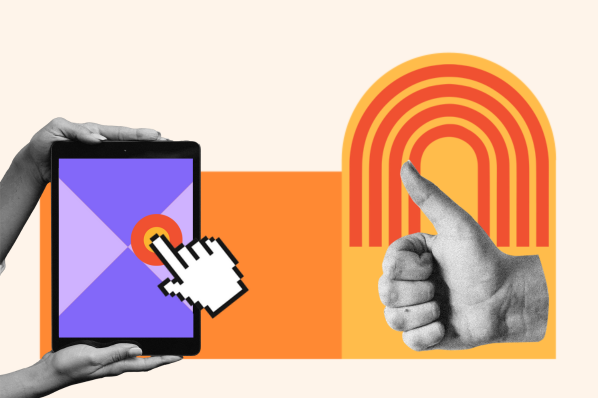As more and more businesses move online, the importance of designing user-friendly interfaces becomes increasingly important.
One of the most effective ways to achieve this is by applying usability heuristics to your user experience strategy. Heuristics are broad guidelines or principles that are applied to your website’s design and improve its usability and user-friendliness.
By adhering to the following usability heuristics, you can ensure that your design is efficient, effective, and easy to navigate for users who interact with your digital products. In this post, we’ll cover every usability heuristic that you need to know to create user-centered designs that enhance visitor satisfaction and overall user experience. From simple and clear language to accommodating errors and providing effective help, these heuristics will help you create highly functional and user-friendly interfaces.
Download Our Free UX Research & Testing Kit
Table of Contents
- What are usability heuristics?
- Why are usability heuristics important?
- 10 Usability Heuristics
- Applying Usability Heuristics to Your Website
What are usability heuristics?
Usability heuristics are a set of guiding principles that evaluate the usability of a user interface. These heuristics were first introduced by Jakob Nielsen in 1994 and have since become the benchmark for evaluating user interfaces. They are crucial in designing effective and efficient websites, apps, and products, as they can identify and address potential usability issues before they become larger problems.
These heuristics cover ten different topics, including visibility of system status, user control and freedom, and consistency and standards. Each heuristic provides a set of guidelines on how to design an interface that is user-friendly, easy to navigate, and intuitive.
Why are usability heuristics important?
One of the primary benefits of usability heuristics is that they provide a common language for designers, developers, and stakeholders to discuss user interface design. Each heuristic represents a specific best practice in interface design, making it easier for everyone involved to understand what needs to be done to create a great user experience.
Another advantage of usability heuristics is that they can help save time and money. By evaluating your user interface against these guidelines, you can identify potential issues early in the design process, which can reduce the cost of fixing these issues later on. Additionally, applying these heuristics can help streamline user testing, making it easier to gather valuable feedback and adjust your design accordingly.
Now that we’ve explained what usability heuristics are and why they’re important, let’s get to the main attraction: Nielsen’s 10 Usability Heuristics with examples of each.
10 Usability Heuristics
1. Visibility of System Status
The first heuristic refers to the system's ability to keep users informed about what is happening and provide feedback within a reasonable amount of time. Essentially, it means that the system should communicate its status to the user through appropriate feedback so the user understands that the system is processing their request.
Example of Usability Heuristic #1
Consider this e-commerce website where users want to add a product to their cart. When the user clicks the "Add to Cart" button, the system should display a message indicating that the product has been added and an updated view of their cart's total. This information should be presented in a visual and accessible manner, such as a pop-up window or a notification icon near the cart icon like in the example below.

Tips for Visibility of System Status
- Visual cues, such as progress bars, animations, or loading icons, indicate that the system is processing the user's request. These cues should be consistent throughout the system and instantly recognizable.
- If your system takes too long to process the user's request or there is no feedback, users may lose patience and become frustrated. Providing quick and meaningful feedback can enhance the user's experience, build trust with the system, and encourage them to continue using the website.
- Make sure feedback messages are clear and concise. Avoid jargon or overly complicated language; provide the user with specific details about what is happening.
2. Match Between System and the Real World
The second heuristic emphasizes the importance of designing interfaces that match the users' existing knowledge and mental models. In other words, the system should speak the users' language, using familiar terms, phrases, and concepts. This way, they can easily understand and navigate the system without the need for extensive learning or training.
Example of Usability Heuristic #2
For this example, here is a video editing software called Veed that we use to create some of our blog’s videos. This interface "matches the real world," as most users who will be using it have an existing understanding of video production or have used other video editing software. Therefore, the interface should use familiar terms such as "clip," "trim," "move," and "delete" to make the editing process easier.
Additionally, the interface should use relevant visual cues to make the system more intuitive. For example, the timeline view may use colors or markers to show different video clips and audio tracks. Users can quickly identify the elements they want to edit without any guesswork.

Tips for Match Between System and the Real World:
- Consider using plain language and simple, recognizable terms that align with users' common knowledge and mental models.
- Ensure that the visual cues you choose represent the corresponding action, making the system intuitive and easy to use.
- Conduct user interviews, surveys, and user testing to gain valuable feedback on your product as it develops.
3. User Control and Freedom
The third heuristic gives users control over the system and enables them to recover from mistakes, providing a sense of freedom within the user experience. The goal is to ensure that users can interact with the system without fear of making mistakes or suffering consequences for their actions. By empowering users, designers can create a more positive user experience, leading to loyal customers.
Example of Usability Heuristic #3
An "Undo" button is an excellent way to provide users with control over the system. It allows users to easily recover from any mistake they make by undoing previously executed actions. The "Ctrl + Z" command is probably the most common application of the "Undo" feature, giving users a sense of control and freedom within their experience.

Tips for User Control and Freedom:
- Clearly label and place your "Exit" or "Cancel" buttons in the user interface so the user quickly understands how to exit or return to a previous stage.
- Undo actions should have obvious methods of execution so the user quickly recovers from any mistakes before they turn detrimental.
- If possible, offer various navigation paths and assistance through the product experience. Doing so will give users more control over how they interact with the product.
4. Consistency and Standards
The next usability heuristic refers to the idea that design elements, such as fonts, colors, buttons, and formats, should be uniform throughout a website or application. In other words, users should not have to relearn how to navigate the site as they move between pages.
A consistent user experience makes the site more intuitive and easy to use, which increases user engagement and reduces user frustration.
Example of Usability Heuristic #4
Let's say a website has multiple pages requiring users to input personal information. If the format and layout of these pages are inconsistent – say they have different fields in different orders and varying labels – the user could become confused and frustrated. However, if the pages are organized in the same way with the same field types and labeling, the user will have an easier time navigating the site and filling out information.
If you have ever filled out a HubSpot form, you’ll notice a seamless transition from the landing page, to the sign-up form, to the thank you page. Each page looks similar, and the fields and buttons on each one match the same pattern.

Tips for Consistency and Standards:
- If you create a style guide, everyone on your design team will use the same design elements, making your final product cohesive and consistent.
- Watch how users interact with your site and ask for their feedback, and use this information to adjust your design to ensure greater consistency.
- Templates can ensure consistency throughout your website. Use a consistent template for each type of page, such as product pages or contact pages, to ensure that design elements are repeated across the site, creating a more intuitive and easy-to-use experience for users.
5. Error Prevention
Error prevention is a usability heuristic that emphasizes the prevention of errors and mistakes in user interaction. This heuristic aims to help designers create intuitive and error-free interfaces, reducing the need for users to correct mistakes or backtrack through their actions. This improves the overall user experience and leads to greater satisfaction.
Example Usability Heuristic #5
A simple example would be this form from The Ringer that automatically validates user input, alerting them immediately if they fail to fill in a required field. The interface below reduces user frustration and improves overall usability by identifying potential errors and offering countermeasures to prevent them.
Tips for Error Prevention:
- Before building your interface, anticipate the different types of user errors that could occur. This could include typos or incorrect data entry, selecting the wrong option, or accidentally deleting information.
- Provide clear and consistent instructions. This will help users understand what is expected of them and what actions they need to take.
- Offer a convenient way for users to report issues or suggest improvements, and use this feedback to improve your design over time.
6. Recognition Rather Than Recall
This heuristic emphasizes the importance of making information and actions visible and available in the interface rather than requiring the user to remember them. This heuristic aims to create an interface that is more intuitive and easy to use by reducing cognitive load and memory demands on the user.
Example of Usability Heuristic #6
eBay displays a list of recently viewed items on its home page, which is an excellent example of "recognition rather than recall." This feature makes it easy for users to find items they recently browsed. They can navigate away from the page and toward other products without losing their place on the original page. This lets users easily compare products on eBay and complete purchases faster without having to track down previously-viewed product pages.

Tips for Recognition Rather Than Recall:
- Clear and consistent labeling for features and functions helps users recognize what they’re looking at rather than requiring them to recall what it is they need to do.
- Visual cues give users clues on what they need to do next without having to remember how to do it.
- Reducing the complexity of your interface will help users easily recognize the information and actions that they need.
7. Flexibility and Efficiency of Use
This heuristic emphasizes the importance of designing interfaces that accommodate a range of user abilities and preferences. The goal is to create an interface that can be used in varied ways, depending on the user's experience level, needs, and preferences, making it more flexible and efficient.
Example of Usability Heuristic #7
The Apple Messages app includes multiple ways to write a message, such as using the keyboard, sending an audio message, or using text-to-speech software via Siri. This app accommodates different user preferences and needs by providing multiple communication methods, making the interface more user-friendly.

Tips for Flexibility and Ease of Use:
- Allow users to customize the interface and features to suit their needs. This can include options to adjust the font size, color contrast, and layout.
- Offer users the ability to access features or commands through keyboard shortcuts.
- Provide only the necessary information and options upfront, gradually revealing more advanced settings or options. This helps prevent users from being overwhelmed by too much information at once.
8. Aesthetic and Minimalist Design
This heuristic recognizes the importance of designing a visually appealing and simple interface. The goal is to create an elegant and functional interface that is not cluttered with unnecessary design elements. These interfaces are easy to navigate and help users focus on the primary task at hand.
Example of Usability Heuristic #8
The Google search engine is a great example of an aesthetic and minimalist design. When users open Google's homepage, they are presented with a simple, uncluttered interface. The white background and minimalistic design allow users to focus on the main task of entering their search query. Even more, Google's search bar is the largest element on the page and is positioned front and center – providing an immediate indication of where the action should occur.

Tips for Aesthetic and Minimalist Design:
- White space can effectively help users focus on the most important parts of the interface. It can also help the design look clean and uncluttered.
- Limiting the number of colors and fonts on your web page or app will create an interface that looks unified and cohesive.
- If you use images in your interface, ensure they are high-quality and align with the overall design aesthetic. Poor-quality images can make the interface look cheap and can detract from the user's experience.
9. Recognize, Diagnose, and Recover Errors
This heuristic helps you design an interface that is capable of handling user errors. The goal is to help users recognize when an error occurs, diagnose what went wrong, and provide options for recovering from the error. This can help improve the user's confidence in the system and reduce frustration caused by errors.
Example of Usability Heuristic #9
A great example of this heuristic is TurboTax, an online tax preparation software. When a user makes an error, TurboTax recognizes it and provides an error message explaining the problem. The error message provides specific details on correcting the problem and allows the user to navigate back to the area where the error occurred. The software even offers a "Help me fix this" button that takes the user to a detailed help article explaining how to fix the error.

Tips for Recognize, Diagnose, and Recover Errors:
- Error messages should be easy to understand and provide specific information on how to fix the problem.
- Along with the error message, provide suggestions for recovering from the error. This could include providing options or links to help the user fix the problem or seek additional assistance.
- Giving users the ability to undo or redo actions can help them recover from errors faster. This is especially useful for complex tasks where errors are more likely to occur.
10. Help and Documentation
This heuristic design principle recognizes the importance of providing users with adequate help and documentation to assist them if/when they encounter issues while using your interface. This includes instructional materials, FAQs, user guides, support chat, and other resources that provide additional information about the product or feature set.
Example of Usability Heuristic #10
Slack is a business communication platform that provides numerous resources to help users better understand and navigate the interface. It has a “Help Center” with documentation that covers frequently asked questions and a Slackbot that offers tips and tricks on how to use the product better. Additionally, Slack support is provided via a dedicated support portal where customers can submit tickets, chat with agents, and access extensive documentation.

Tips for Help and Documentation:
- Make sure help and documentation resources are easily accessible from within the interface. This could include providing links to help articles, accessible support chat, or in-app help features.
- Consider using videos, images, diagrams, and other forms of multimedia to help users better understand how to use your interface.
- Use customer feedback to update your documentation and help you tailor it to your users' needs.
Applying Usability Heuristics to Your Website
Usability heuristics are essential for designing effective, efficient, and easy-to-navigate interfaces. By implementing these guidelines in your design process, you will be able to create interfaces that prioritize the user and enhance their experience with your company’s products and services.
Author's Note:This post was written/edited by a human with the assistance of generative AI.




![Website Navigation: How to Design Menus Visitors Love [Examples]](https://knowledge.hubspot.com/hubfs/ft-nav-bar.webp)


![How to Become a UX Designer, a Step-By-Step Guide [+Expert Tips]](https://knowledge.hubspot.com/hubfs/become-a-ux-designer-1-20240731-321437.webp)


